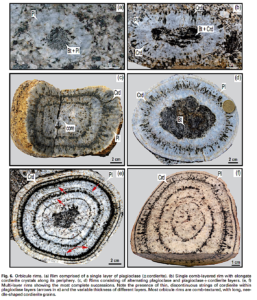Barbey, P. ; Grandprat, M. ; Faure, F., (2021) J. of Petrology, 1-23
Voir en ligne : https://academic.oup.com/petrology/article/62/7/egab063/6321460

Abstract :
The Lafaye orbicular body was emplaced in the Villatange tonalite-granodiorite unit of the Guéret magmatic complex (Massif Central, France). It consists of plagioclasic orbicules (4–35cm diameter) embedded in homogeneous cordierite granodiorite. Orbicule cores consist mostly of residual metasedimentary xenoliths or autolithic plagioclasic cumulates. Rims (0.7–8cm thickness) are single- or multi-layered ; layers, mostly comb-textured, comprise alternating sheets dominated by cordierite (XFe¼0.32–0.37) or plagioclase (mostly An25–30). Additional mineral phases are minor biotite (XFe¼0.52 ; AlVI¼0.58–0.92 atoms per formula unit) and interstitial quartz. Plagioclase and cordierite morphologies (needle-like, skeletal, branching or fan-shaped) indicate growth under high initial supersaturation. However, the final polyhedral shapes and primary zoning of many individual plagioclase crystals, as well as evidence of partial recrystallization, imply significant textural maturation. Whole-rock major and trace element data (A/CNK¼1.12–1.46) and Sr and Nd isotopic compositions (eNd(355 Ma) =-8.6 to -7.4 ; 87Sr/86Sr(355 Ma) =0.7110–0.7147) suggest that the parental magma of the orbicules resulted from bulk assimilation of aluminous metasediments by a Villatange-type granodioritic magma. Heterogeneous nucleation and growth of plagioclase and cordierite around xenoliths/autoliths are interpreted in terms of (1) adiabatic decompression of magma pulses ascending in dykes leading to superheating and resorption of early solids, and (2) volatile exsolution, inducing undercooling, supersaturation, and rim crystallization. The variability of layers (number, thickness, mineral distribution, and texture) is considered to result from oscillatory crystallization combined with variable plagioclase growth rates linked to changes in the degree of supersaturation as a function of the extent of melt degassing, itself linked to magma transfer dynamics




